Enrollment Duration in the Conservation Reserve Program
TOPICS
USDA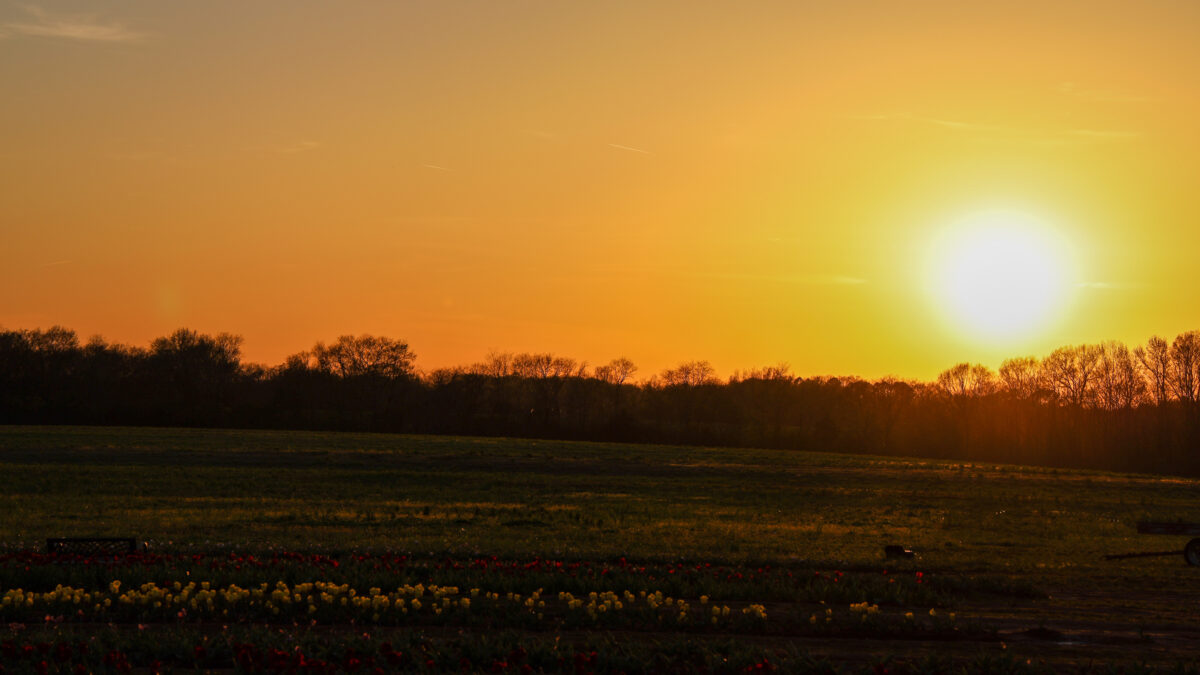
photo credit: Alabama Farmers Federation, Used with Permission
John Newton, Ph.D.
Vice President of Public Policy and Economic Analysis
The Conservation Reserve Program is a voluntary program that pays farmers and ranchers to retire environmentally sensitive cropland. Contracts for land enrolled in CRP are 10 to 15 years in length, yet USDA Farm Service Agency data recently revealed that nearly one-quarter of all land enrolled in CRP has been enrolled for more than 20 years, and 12 percent of CRP acres have been enrolled for 30-plus years. This interactive Tableau Public mobile device dashboard identifies the distribution of CRP acreage by state and length of enrollment.
In exchange for retiring cropland, improving environmental health and land quality, as well as enhancing wildlife habitat, USDA provides a yearly rental payment to farmers. Since CRP was implemented in 1987, and in partnership with farmers and ranchers, USDA has contributed nearly $50 billion to achieve the environmental and wildlife benefits of CRP.
Acreage enrollment in CRP varies each year based on several factors including the number of acres under expiring contracts, FSA rental rates, the frequency of general sign-up enrollment, and acreage caps established by Congress. Currently, USDA CRP enrollment data reveals that for the 2016 fiscal year 23.9 million acres were enrolled in CRP. A recent Market Intel reviewed trends in CRP enrollment and potential farm bill implications, Change on the Horizon for the Conservation Reserve Program?
Duration of CRP Enrollment
Acreage enrolled in CRP reached a high of 36.7 million acres in 2007. However, since 2007 the acreage cap established by Congress has been periodically lowered. In addition to the congressional limitations, higher returns from crop production led to many landowners pulling land out of the CRP program upon their contracts’ expiration. Since 2007 nearly 13 million acres have come out of the CRP program – primarily from the High Plains and Southwest, Figure 1.
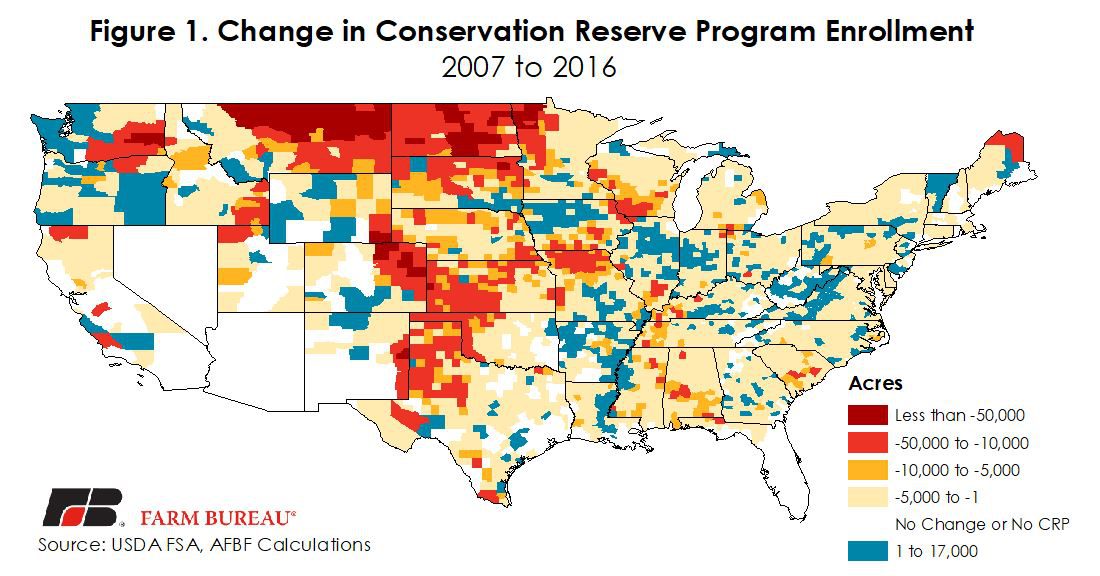
While congressional directives and a favorable farm economy led to lower CRP enrollment, nearly one-quarter of all land enrolled in CRP has been enrolled for more than 20 years, and of that, 2.7 million acres or 12 percent of CRP lands have been enrolled for more than three decades. That means that 12 percent of active CRP contracts have been in effect since the program began in 1987.
According to USDA Farm Service Agency data, of the 23-plus million acres enrolled in CRP, nearly 47 percent or 10.9 million acres have been enrolled less than 10 years. The remaining 53 percent of CRP acres have been enrolled for more than 10 years. Of these acres, approximately 31 percent or 7.2 million acres have been enrolled for 10 to 20 years, 11 percent or 2.6 million acres have been enrolled for 20 to 30 years, and nearly 12 percent or 2.7 million acres have been enrolled for 30-plus years. Figures 2 through 5, and this interactive Tableau Public mobile device dashboard details CRP acreage by state and length of enrollment.
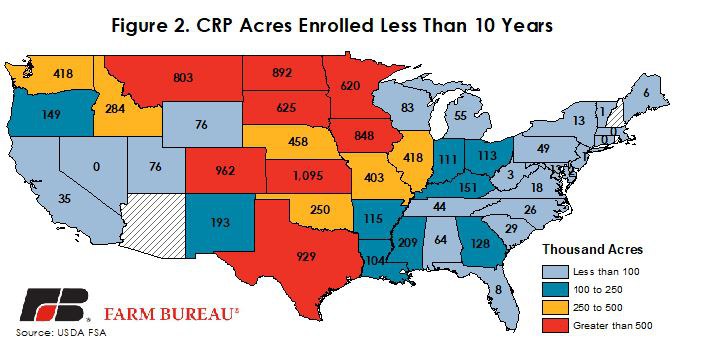
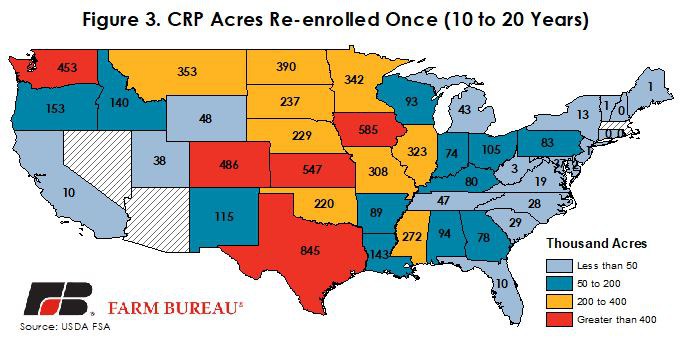
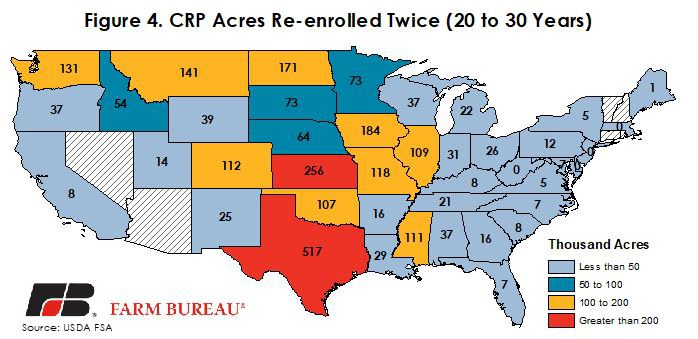
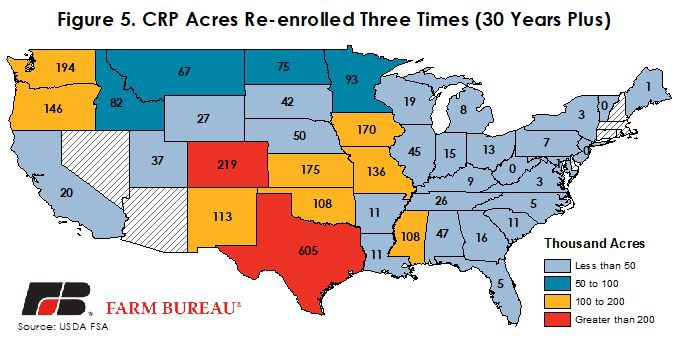
As identified in Figures 2 through 5, a majority of the CRP acres enrolled for 20 to 30 years is in the Southwest, West and Southeast. In these areas, cropland and pastureland have had more than 30 percent of their CRP lands enrolled for 20 to 30 years. These landowners have made additional long-term investments in improving environment and soil quality and enhancing wildlife habitat by idling cropland in the CRP program.
Implications
Currently, data is not available that identifies the breakdown of the acreage by enrollment duration and whether the acres fall in continuous or general sign-up. This information is important when considering the length of CRP enrollment as each sign-up option is associated with different environmental goals.
CRP acreage under continuous enrollment meets specific FSA long-term initiatives to control soil erosion, improve water quality or enhance wildlife habitat, and it follows that these environmentally sensitive croplands would have been enrolled in CRP for longer periods of time to achieve specific USDA goals.
General sign-up, however, does not meet specific FSA initiatives; rather these lands enter CRP through a competitive bidding process based on an environmental benefits index, rental rates and the likelihood that the practice will continue after the contract expiration. Lands under general sign-up may enter on a more impromptu basis than more environmentally sensitive continuous sign-up lands.
Reviewing the duration of CRP acreage enrollment is timely given that 17.7 million acres are set to expire from the CRP program by the 2028 crop year – a majority enrolled under general sign-up. With millions of acres set to come out of retirement, policymakers may consider which type of cropland to prioritize, i.e. continuous or general sign-up, and how long acres should remain in CRP. There is a renewed interest on Capitol Hill in modifying the CRP program in the next farm bill to allow for increased enrollment.
As this debate continues, Farm Bureau members, policymakers and industry stakeholders will closely analyze a variety of factors including impact on young farmers and ranchers, length of CRP enrollment, CRP rental rates, the type of cropland eligible, how much cropland is eligible, and how much of a farm’s or county’s acreage is eligible for CRP. Careful consideration of these factors could improve the environmental benefits achieved and the overall functionality of the CRP program.
Top Issues
VIEW ALL